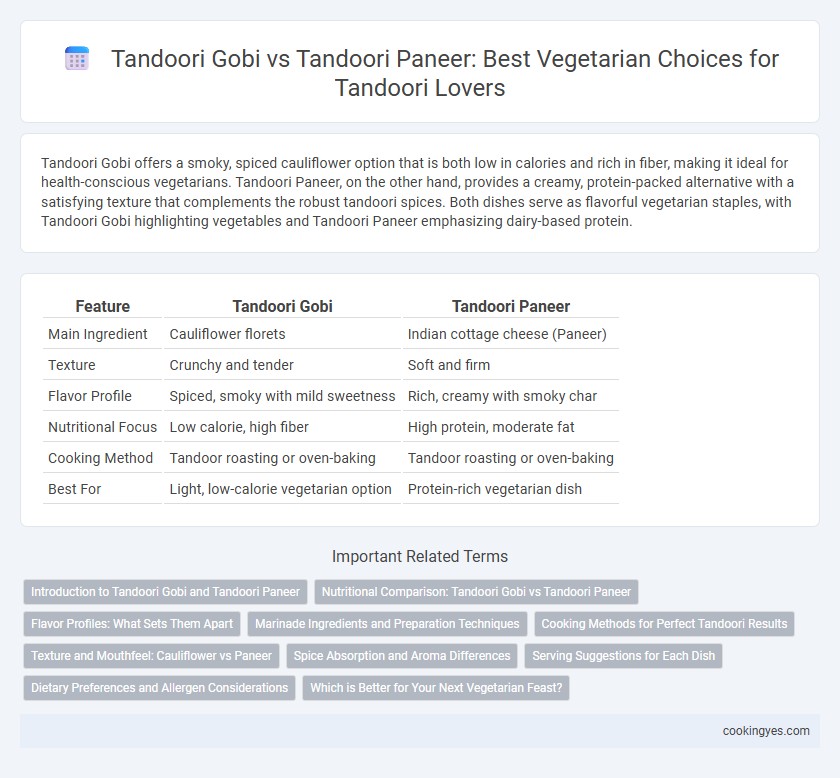Tandoori Gobi offers a smoky, spiced cauliflower option that is both low in calories and rich in fiber, making it ideal for health-conscious vegetarians. Tandoori Paneer, on the other hand, provides a creamy, protein-packed alternative with a satisfying texture that complements the robust tandoori spices. Both dishes serve as flavorful vegetarian staples, with Tandoori Gobi highlighting vegetables and Tandoori Paneer emphasizing dairy-based protein.
Table of Comparison
| Feature | Tandoori Gobi | Tandoori Paneer |
|---|---|---|
| Main Ingredient | Cauliflower florets | Indian cottage cheese (Paneer) |
| Texture | Crunchy and tender | Soft and firm |
| Flavor Profile | Spiced, smoky with mild sweetness | Rich, creamy with smoky char |
| Nutritional Focus | Low calorie, high fiber | High protein, moderate fat |
| Cooking Method | Tandoor roasting or oven-baking | Tandoor roasting or oven-baking |
| Best For | Light, low-calorie vegetarian option | Protein-rich vegetarian dish |
Introduction to Tandoori Gobi and Tandoori Paneer
Tandoori Gobi features cauliflower marinated in a blend of yogurt and aromatic spices, roasted in a traditional clay tandoor for a smoky flavor and tender texture. Tandoori Paneer offers cubes of Indian cottage cheese similarly marinated and grilled, providing a creamy and protein-rich vegetarian option. Both dishes deliver authentic North Indian taste profiles and are popular choices in tandoori cuisine for vegetarians seeking flavorful, spiced entrees.
Nutritional Comparison: Tandoori Gobi vs Tandoori Paneer
Tandoori Gobi offers a low-calorie, fiber-rich option with high vitamin C and antioxidants from cauliflower, making it ideal for weight management and digestive health. Tandoori Paneer provides a protein-dense choice with substantial calcium and healthy fats, supporting muscle growth and bone strength. Both dishes are rich in spices with anti-inflammatory properties, but paneer delivers higher protein and fat content compared to the lighter, nutrient-packed gobi.
Flavor Profiles: What Sets Them Apart
Tandoori Gobi offers a smoky, charred flavor with a slight natural bitterness from cauliflower, complemented by turmeric, cumin, and garam masala spices. Tandoori Paneer, on the other hand, delivers a creamy, rich texture that absorbs robust tandoori marinade flavors, including yogurt, chili powder, and coriander. The primary distinction lies in Gobi's earthy crispness versus Paneer's soft, melt-in-your-mouth quality, making each a unique vegetarian delight.
Marinade Ingredients and Preparation Techniques
Tandoori gobi features marinated cauliflower florets coated in a blend of yogurt, turmeric, red chili powder, garam masala, and ginger-garlic paste, allowing the spices to deeply penetrate before being charred in a clay tandoor oven for a smoky flavor. Tandoori paneer uses a similar yogurt-based marinade with added kasuri methi and lemon juice to enhance the soft, creamy texture of paneer cubes, which require careful grilling to prevent drying. Both dishes rely on prolonged marination and high-heat tandoor cooking, but cauliflower's porous texture absorbs spices differently than paneer's dense consistency, resulting in distinct taste and mouthfeel profiles.
Cooking Methods for Perfect Tandoori Results
Tandoori gobi and tandoori paneer achieve perfect results through marination in yogurt and spices followed by cooking in a traditional clay tandoor oven at high temperatures. The key to tandoori gobi's tenderness lies in parboiling the cauliflower before skewering, while tandoori paneer requires careful handling to prevent crumbling and maintain a soft, creamy texture. Optimal cooking times differ; gobi benefits from longer exposure to ensure charred edges, whereas paneer cooks quickly to avoid drying out.
Texture and Mouthfeel: Cauliflower vs Paneer
Tandoori gobi offers a unique texture with its slightly crisp and charred exterior while maintaining a tender, juicy interior that enhances its earthy cauliflower flavor. In contrast, tandoori paneer provides a creamy, dense mouthfeel that absorbs smoky spices, resulting in a rich and smooth bite. The choice between cauliflower and paneer in tandoori dishes depends on whether one prefers a light, fibrous texture or a more substantial, velvety experience.
Spice Absorption and Aroma Differences
Tandoori gobi absorbs spices differently compared to tandoori paneer due to its porous texture, allowing flavors like cumin, coriander, and garam masala to penetrate deeply and create a robust, earthy aroma. Tandoori paneer, with its dense and creamy consistency, retains marinades on the surface, resulting in a milder spice profile and a rich, smoky scent from the tandoor cooking process. These variations in spice absorption and aroma make tandoori gobi ideal for bold flavor enthusiasts, while tandoori paneer offers a subtler, aromatic vegetarian option.
Serving Suggestions for Each Dish
Tandoori Gobi pairs excellently with green chutney and a side of fresh salad, enhancing its smoky flavor while maintaining a light, crispy texture. Tandoori Paneer is best served with mint yogurt dip and naan, balancing the rich, creamy paneer with cooling, aromatic accompaniments. Both dishes complement cumin rice or roti, providing a satisfying vegetarian meal with diverse taste profiles.
Dietary Preferences and Allergen Considerations
Tandoori gobi offers a gluten-free, low-calorie option suitable for those avoiding dairy and soy, making it ideal for vegans and individuals with lactose intolerance. Tandoori paneer provides a rich source of protein and calcium but contains dairy, which may trigger allergies or sensitivities in some individuals. Choosing between tandoori gobi and paneer depends on specific dietary preferences, allergen concerns, and nutritional goals within vegetarian diets.
Which is Better for Your Next Vegetarian Feast?
Tandoori gobi offers a flavorful, low-calorie option rich in vitamins and antioxidants, making it ideal for health-conscious vegetarians seeking a nutritious feast. Tandoori paneer, with its high protein and calcium content, provides a creamy, satisfying choice that supports muscle repair and bone health. For a well-rounded vegetarian meal, combining both tandoori gobi and paneer can enhance taste diversity and nutritional balance.
Tandoori gobi vs Tandoori paneer for vegetarian options Infographic

 cookingyes.com
cookingyes.com